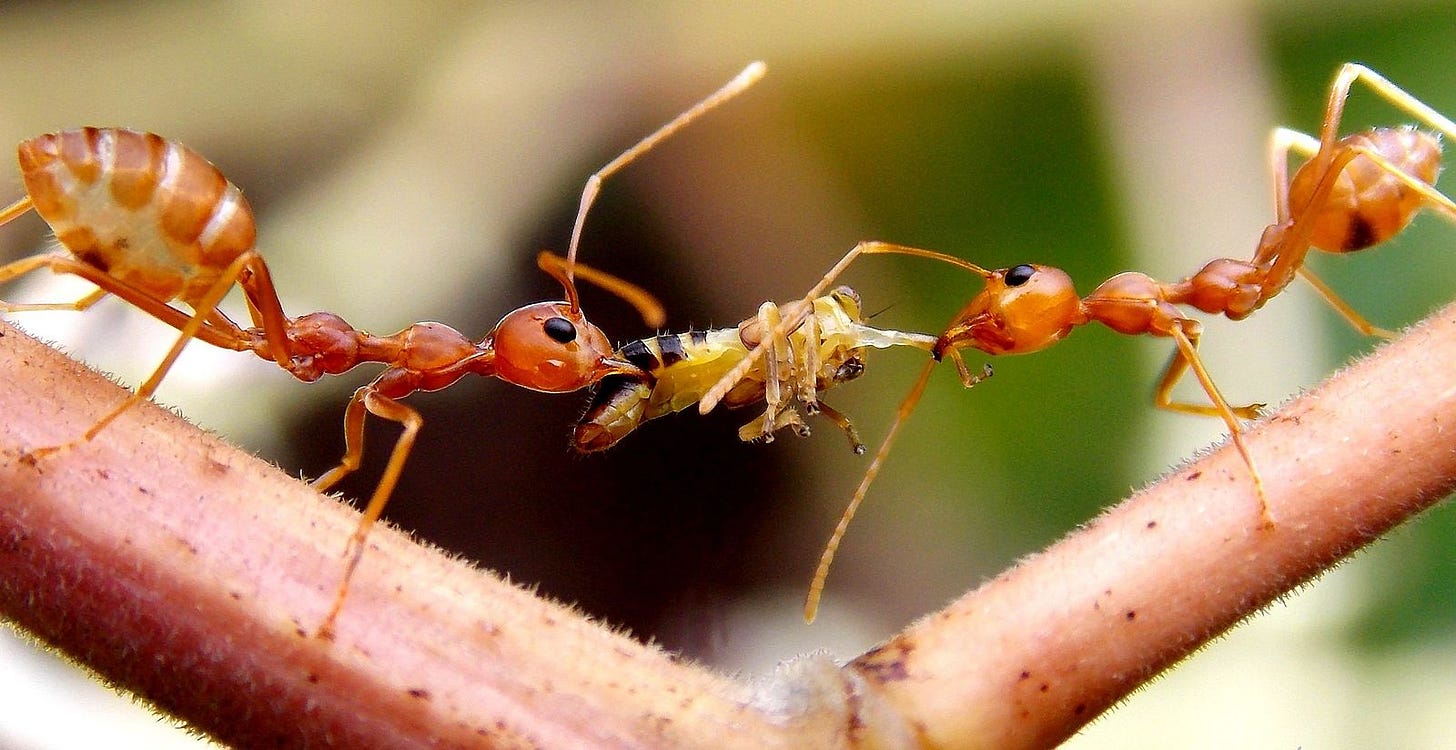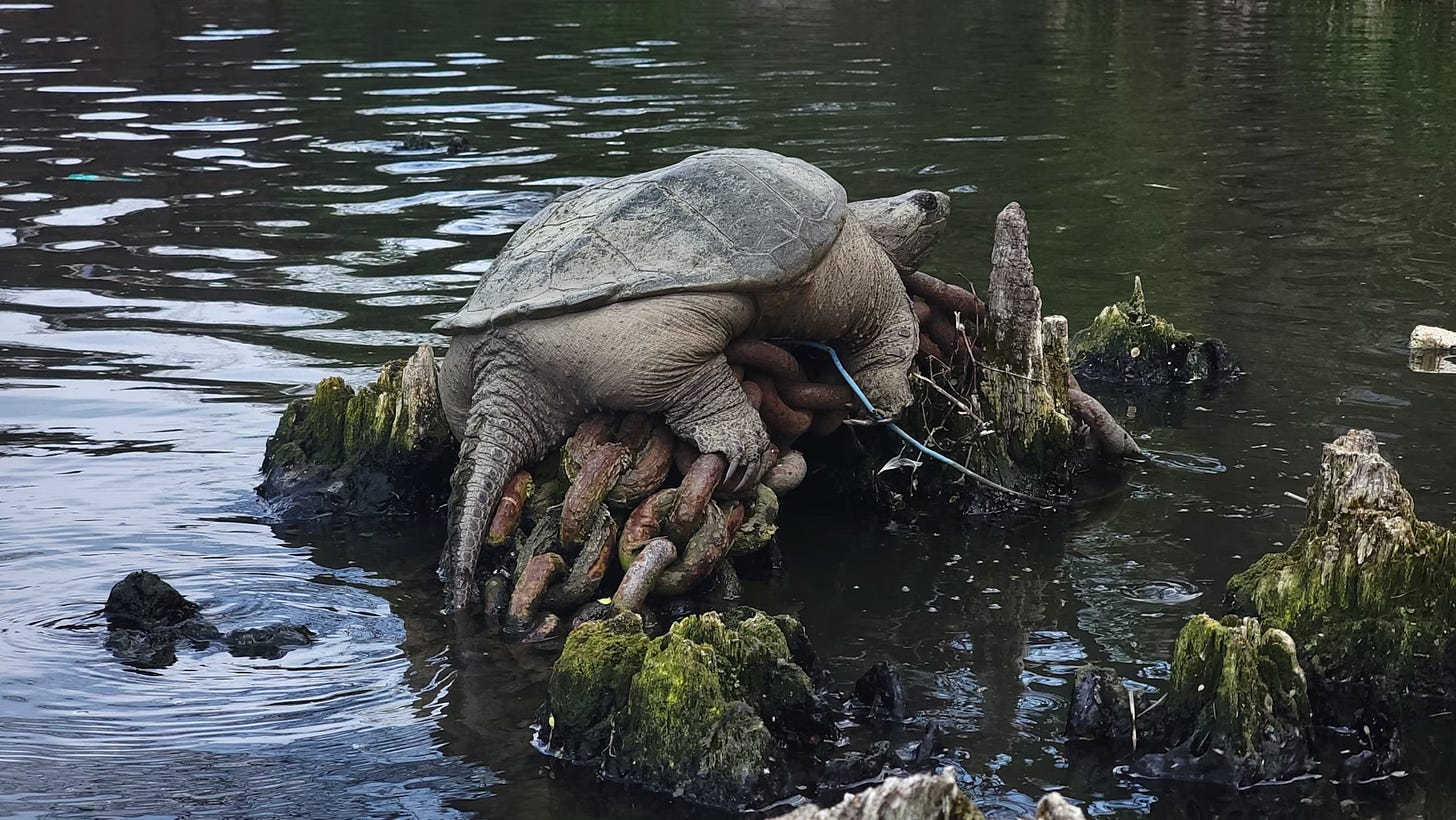Baby-Blood-Sucking Ants May Be In Your Backyard
Known as vampire or Dracula ants, these insects have a rather gruesome (but ultimately harmless!) way of surviving.
This week, as I worked on chapters for my upcoming book — SORT OF FUNNY FIELD GUIDES (2025) — I got to return to an earlier interview I did with Corrie Moreau, a super cool scientist who studies ants at Cornell University. And as always, when it came time to write the chapter, I couldn’t possibly include every cool thing Moreau said.
But this is actually good news, because it means I get to bring those cool things to you now! So, are you ready to talk about the ants who drink the blood of babies?
Don’t worry. We’re talking about ant babies. Specifically, the ants’ own babies. Which somehow makes this fascinating behavior both better and worse.

Meet The Vampire Ants
Okay, so the first thing Moreau blew my ding-dang mind with was the fact that adult ants, in general, cannot eat solid food. This is because their waists are actually too small to allow solid food to pass through to the abdomen.
Like, imagine your belt being cinched so tight, chewed-up cookies physically can’t get through to your intestines. Wild.
This means that adult ants largely subsist on sugar water, in the forms of nectar, tree juices, and whatever liquids they can suck out of particularly juicy prey items, such as caterpillars. And this sugar-water-slurpee diet mostly fulfills their dietary needs.
Of course, all of this begs the question, if adult ants are on a strictly liquid diet, why do we always see them carrying around crumbs and grasshopper drumsticks?
Believe it or not, those big, solid meals so archetypal of ants ruining a picnic are actually destined for the ant babies (larvae) back inside the nest. Moreau says you can think about the larvae as “sacks with a mouth.” And at this stage in their lives, that’s basically all the baby ants need. They are literally little more than eating machines.
As they develop, these ravenous little larvae require bodybuilder-levels of protein. And the adult ants supply them such in the form of all those solid foods we see them dragging underground.

Now, to complicate this arrangement, adult ant workers and even the queen ant do sometimes need a little protein to go with their sugar-water. And the way they get it is pretty cool.
“A worker can go over and drum on the larva with its antenna, and this signals to the larva to regurgitate some of that food, now that it's essentially been turned into a protein milkshake,” says Moreau. “The workers then can either share it with each other or feed it to the Queen.”
Beautiful system, right? The young of the colony get fed a steady stream of growth-building foodstuffs, which they in turn process and share with their elders who are physically incapable of eating such foods otherwise. Kumbaya, and all that.
However, not all ant larvae are good sharers. And some species cannot perform the nutrient-exchange behavior (known officially as trophallaxis). But those workers still need that protein, protein that’s just sitting there inside the larvae. So what’s an ant to do?
Well, if you’re a vampire ant, you take it.
“The workers actually bite a hole into the larva, and then lick up the exuding hemolymph, or blood, to get access to protein to share around the nest, especially with the queen,” says Moreau. “But it's actually called non-destructive cannibalism because the larva are not harmed.”
In fact, the ant babies continue to develop and ultimately grow up into totally healthy adults. Albeit adults with lifelong signs of trauma.
“They are actually heavily scarred from being fed on so many times,” says Moreau.
Best of all, while so-called Dracula or vampire ants are best known from Madagascar, there are in fact a few species right here in North America. Which means there may be baby-blood-drinking insects in your backyard as we speak.
Long Live Chonkosaurus!
In other news, I got to write about Chonkosaurus, the hefty common snapping turtle that had the internet buzzing this week. As with those weirdo ants above, experts say Sir Chonk is pretty big for his species, but that such turtles are common across their North American range. We just don’t often see the reptiles because they’re nocturnal, can stay underwater for up to three hours at a time, and generally just don’t want much to do with us.
Click here to read about Chonkosaurus, the internet’s favorite snapping turtle!
*Bonus Dracula Ant Content*
A thing that happens to me not infrequently is I’ll be researching a story—or a newsletter post like this—and I’ll come across an article on the internet that is super relevant to my needs, and I’ll think, “This is perfect!”
And then I’ll realize that it was me who wrote the article, but also that no memory of it remains.
I’d like to think this means my brain is just archiving old material to make way for new stuff, but the truth is either just that I’m getting old or maybe I’ve written so many weird animal stories at this point I simply can’t keep track of them all. (This may also explain the blank stare I get sometimes when people ask me about something I’ve written—please pause the conversation while I scan my memory for what the heck you’re talking about!)
Anyway, it turns out that I wrote about Dracula ants for National Geographic News in 2018 when a new study concluded that they possess the fastest jaws (and the fastest movement) found in nature. I won’t be surprised if that crown has now been passed on to some other animal, as it’s been five years and we’re discovering new, awesome stuff all the time. But it’s a fun story either way. And there’s a video to go with it.
Thanks for reading, everybody. And enjoy!





